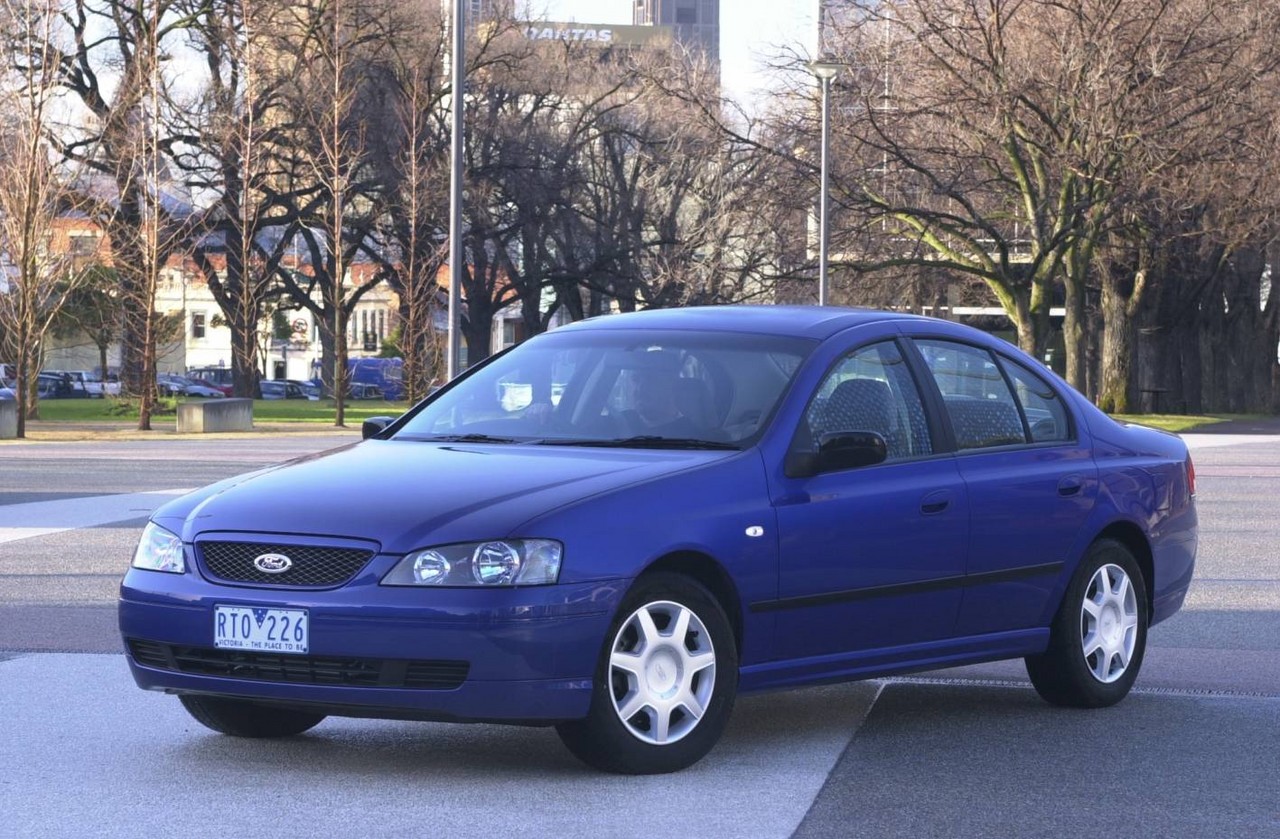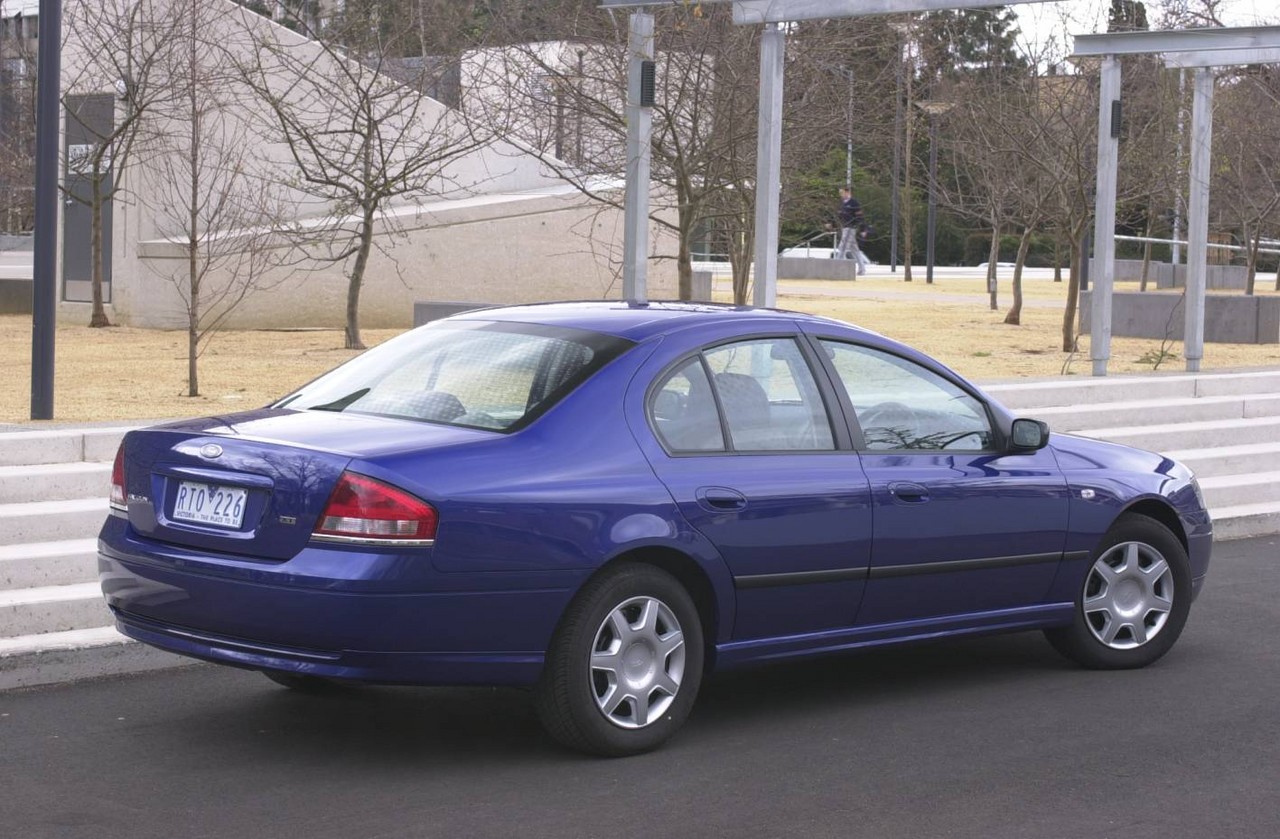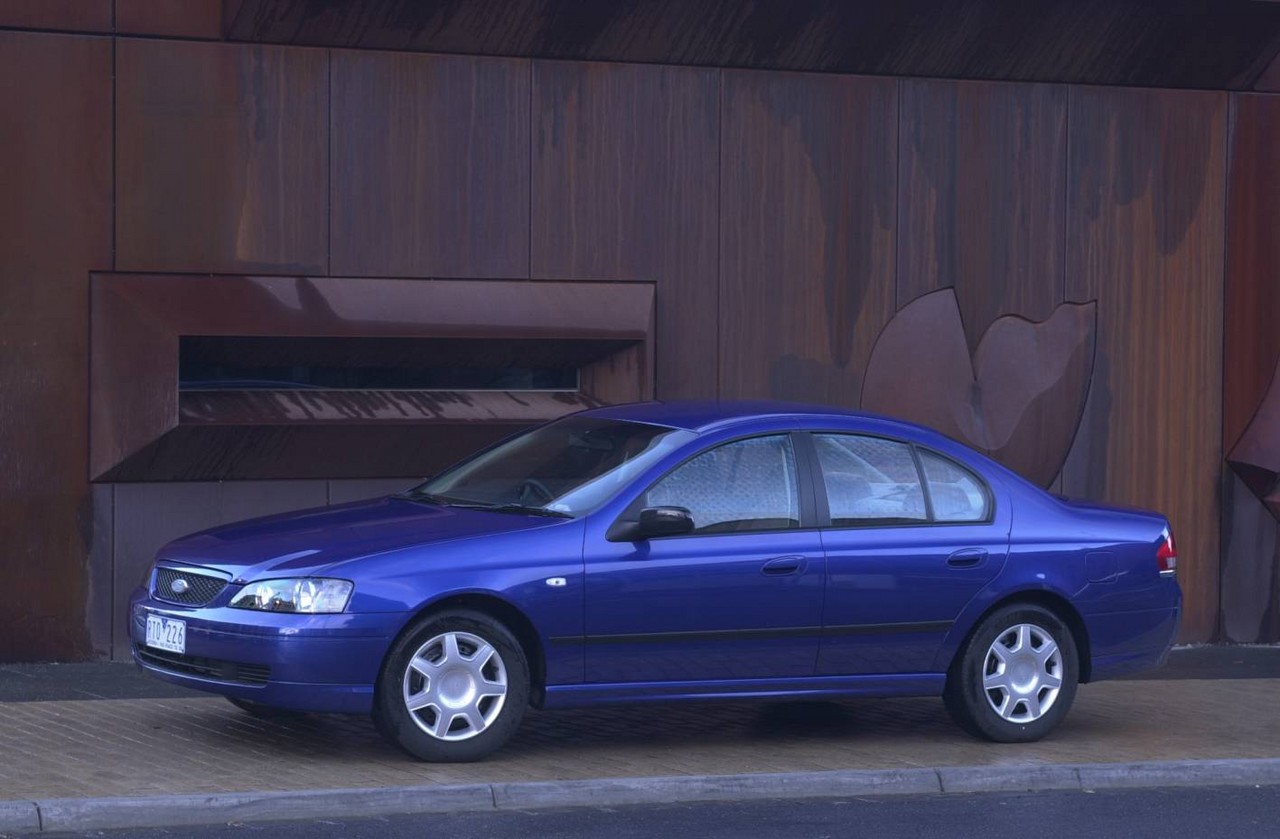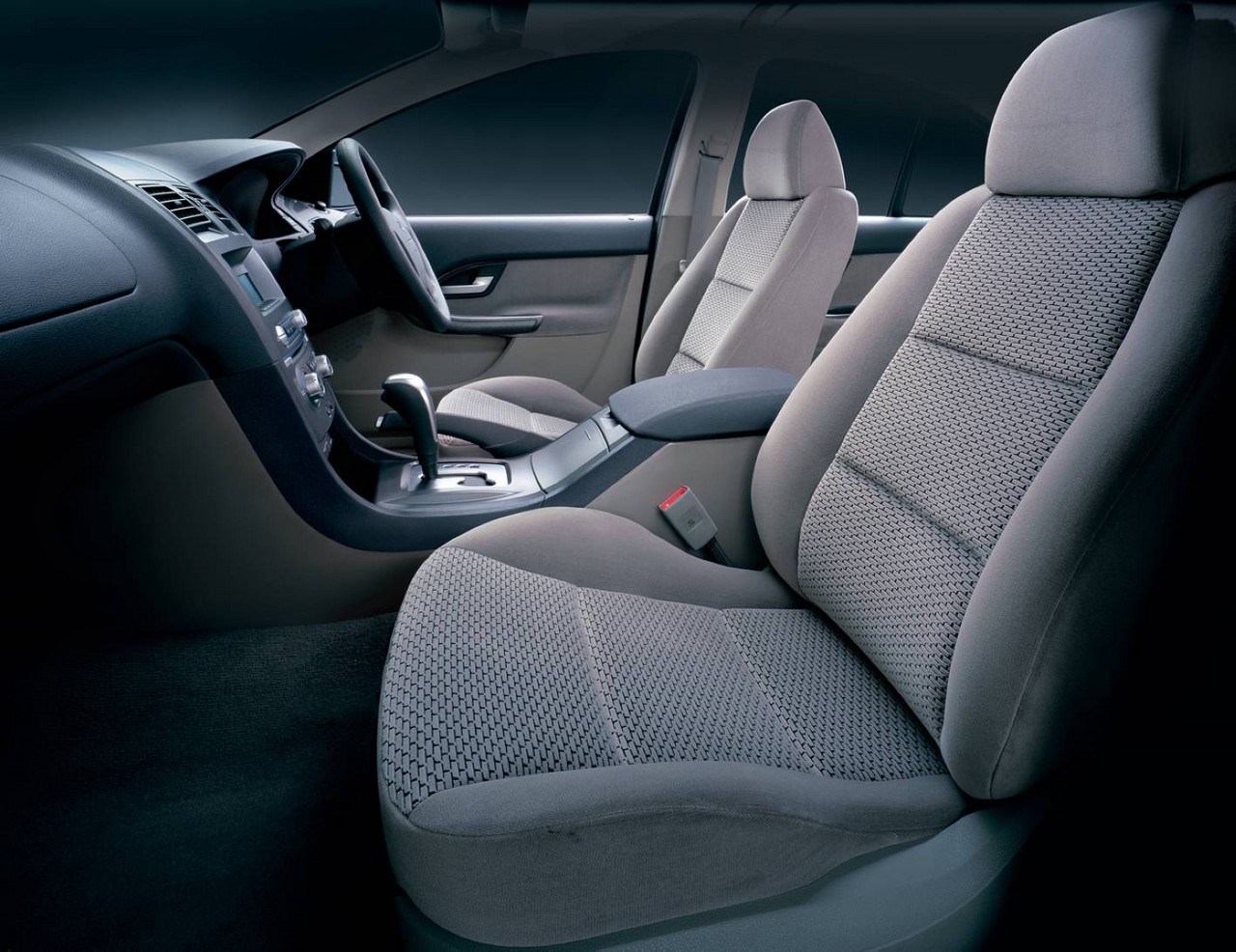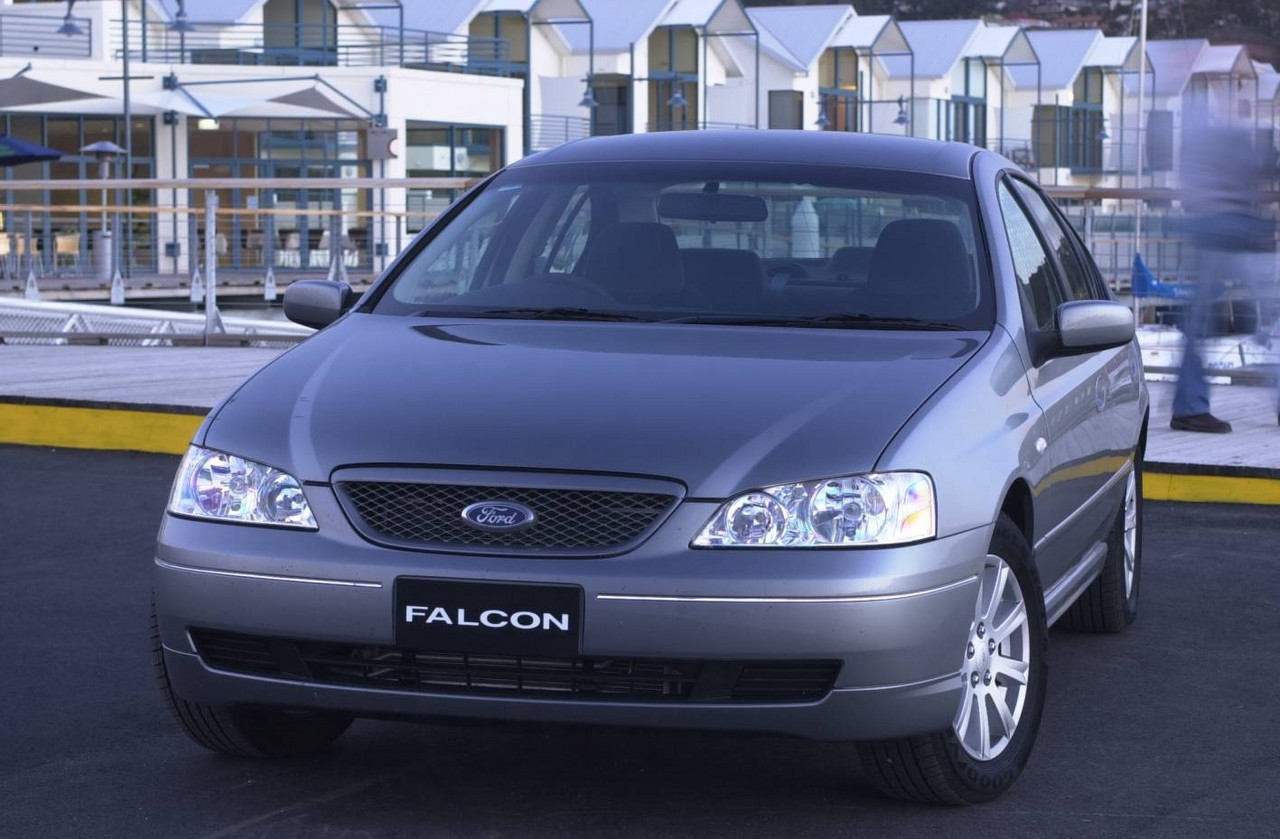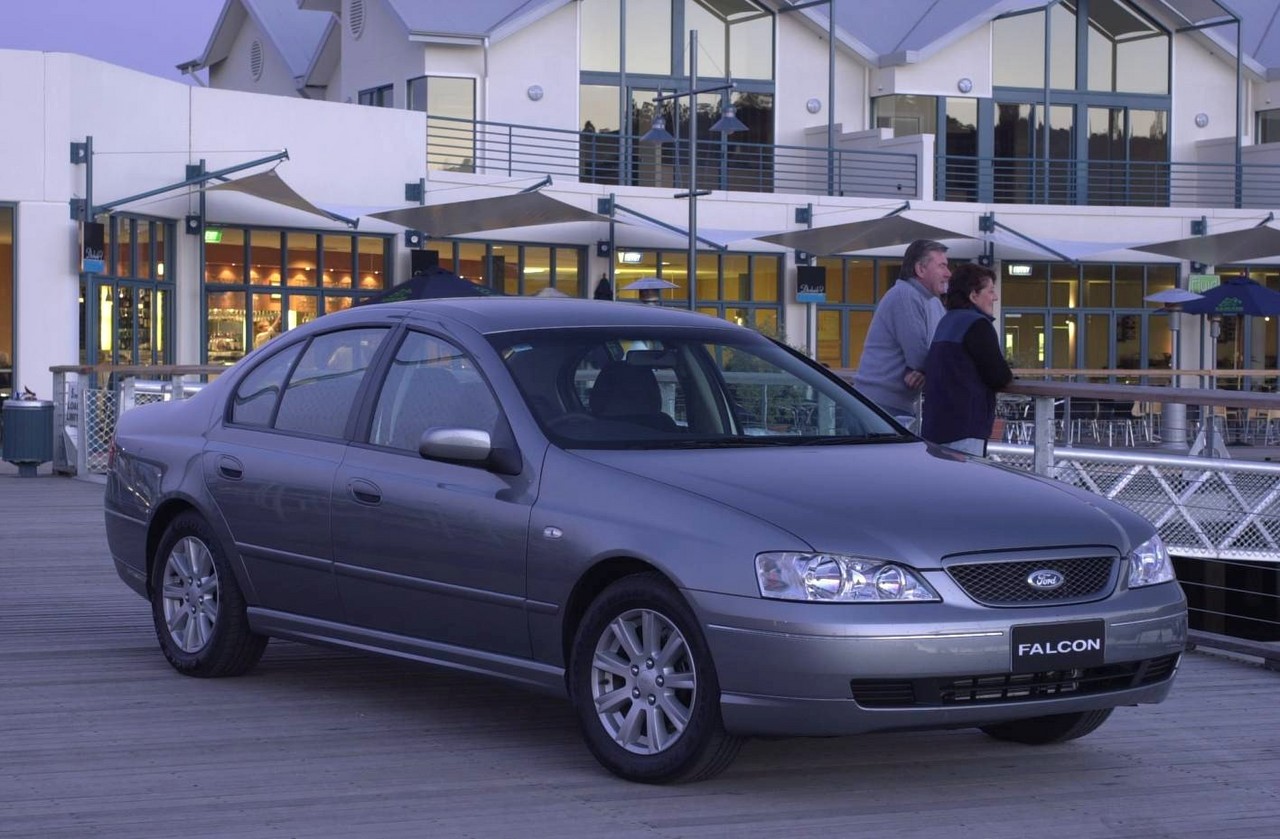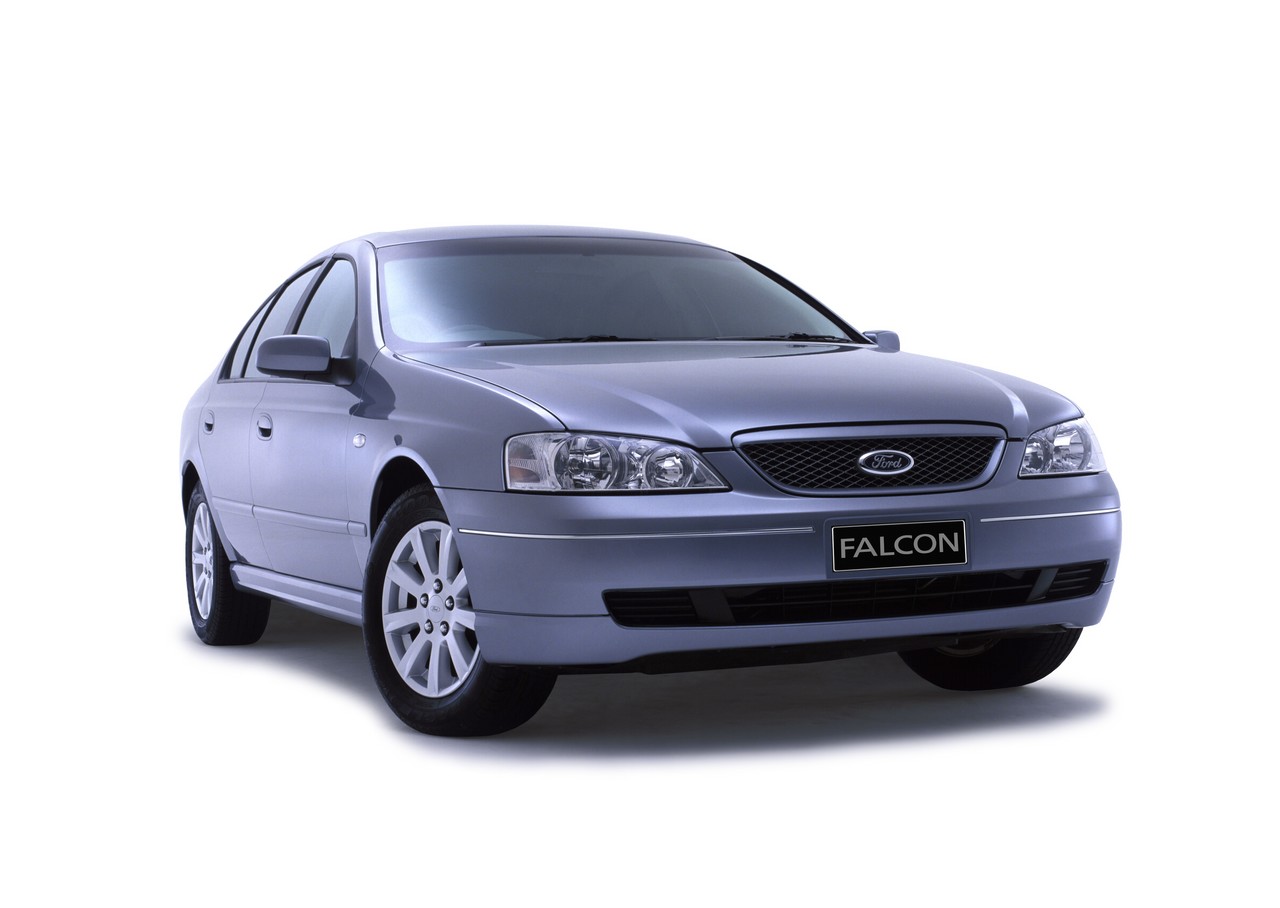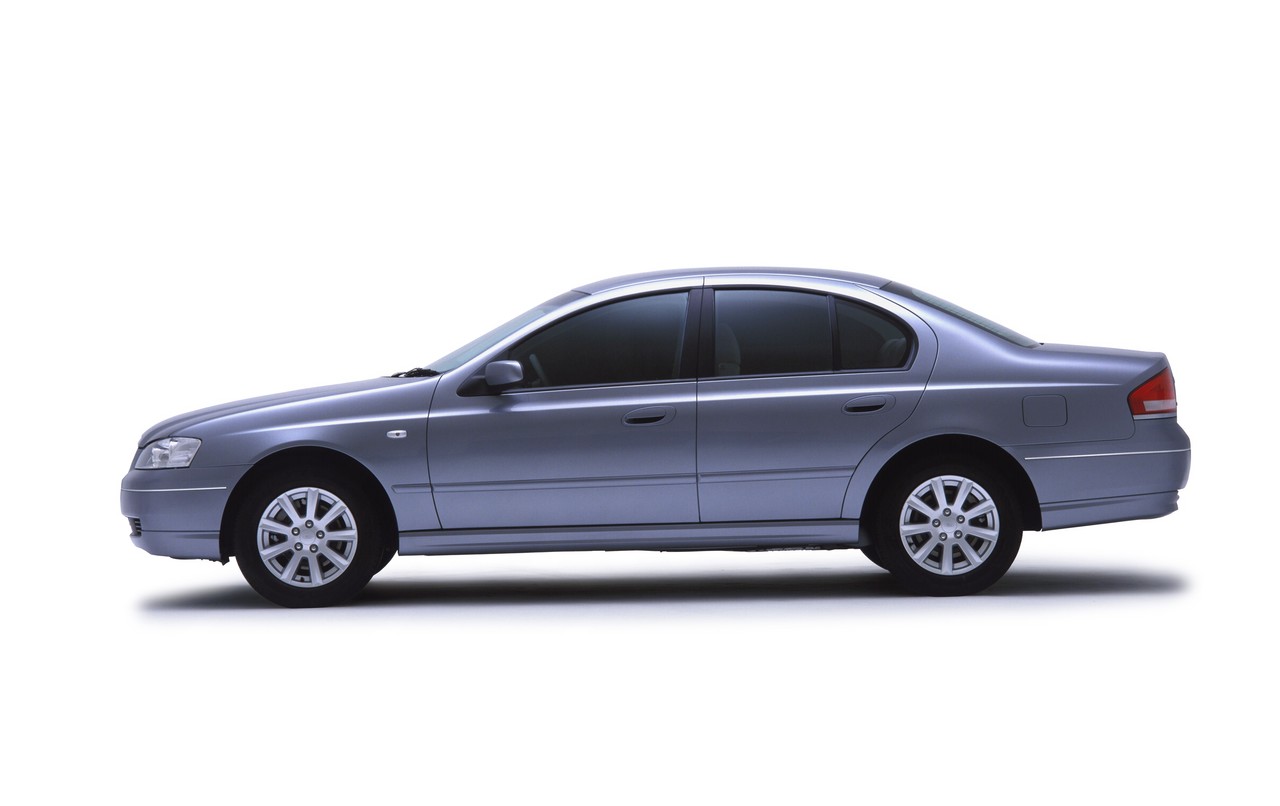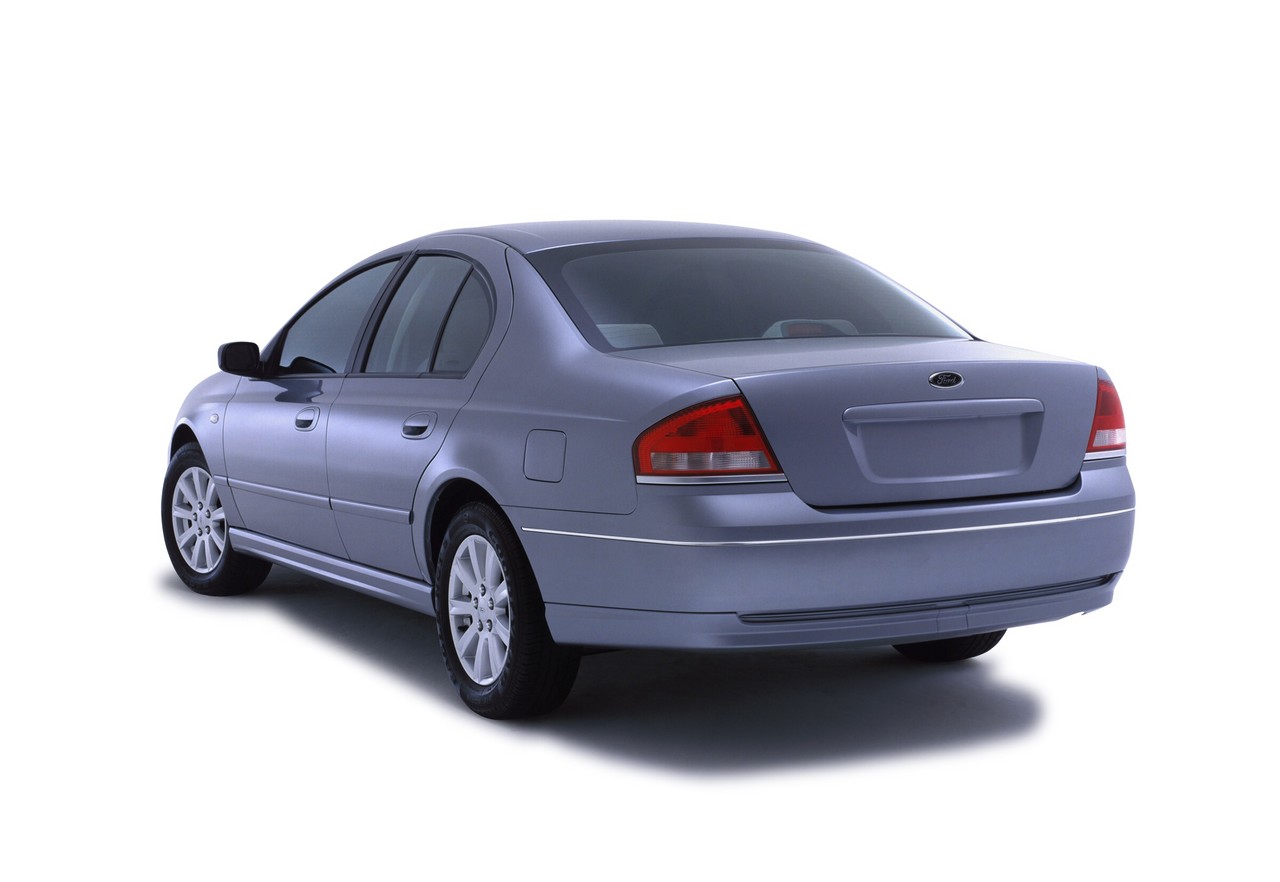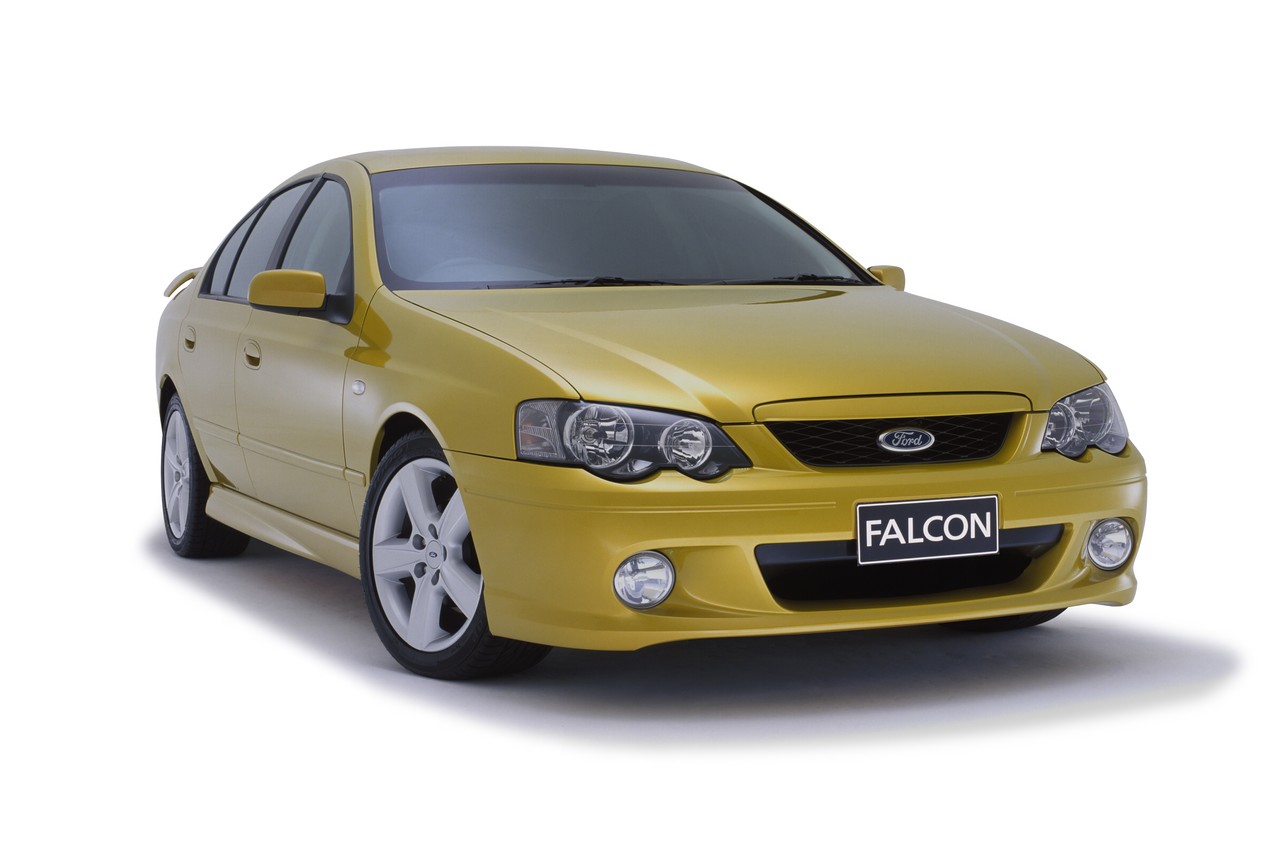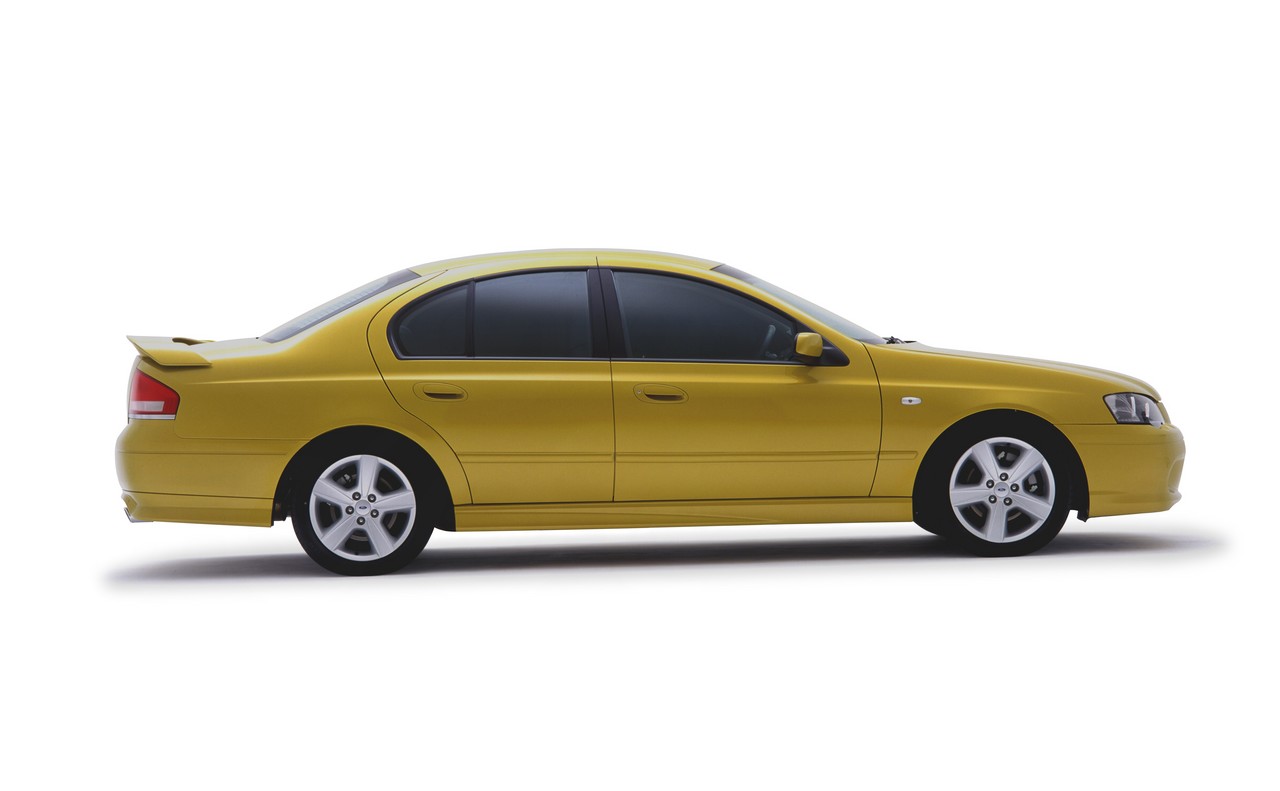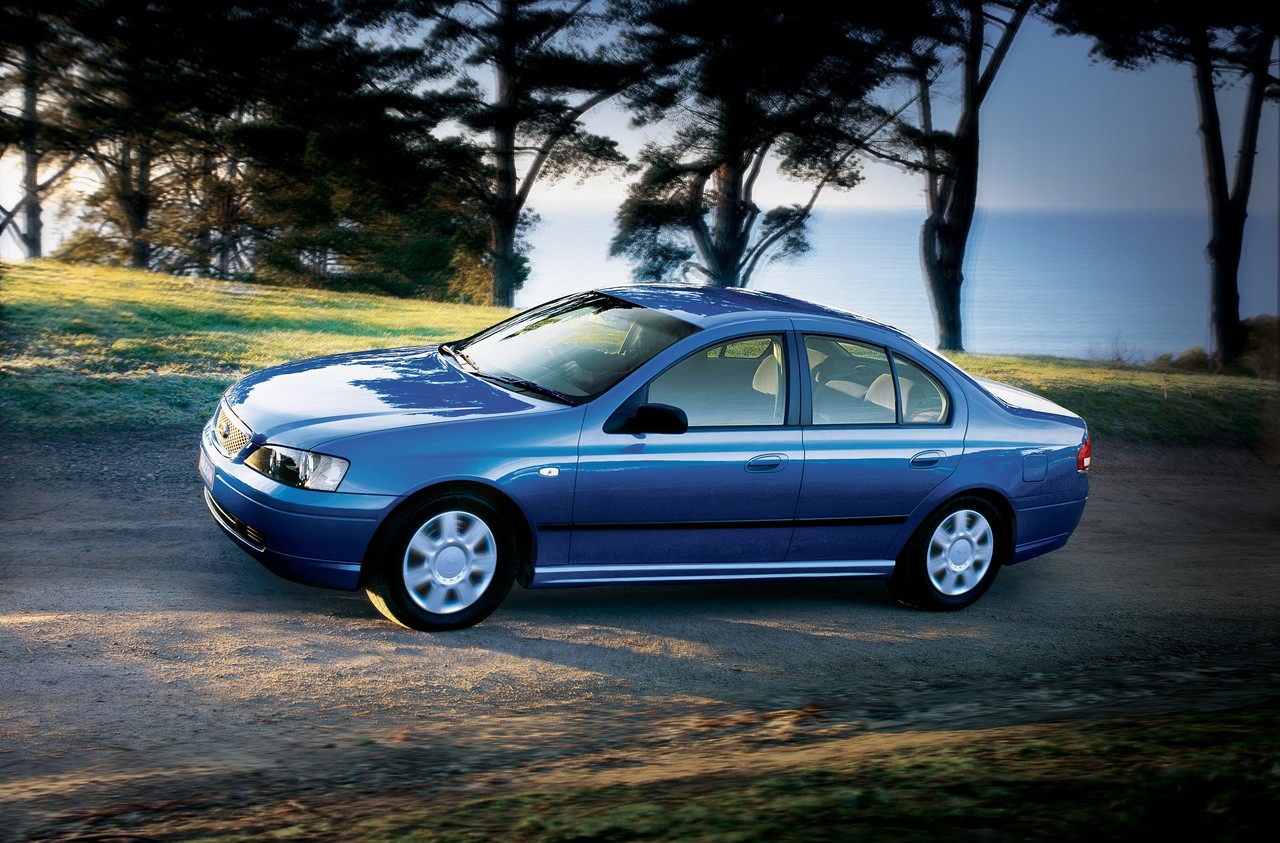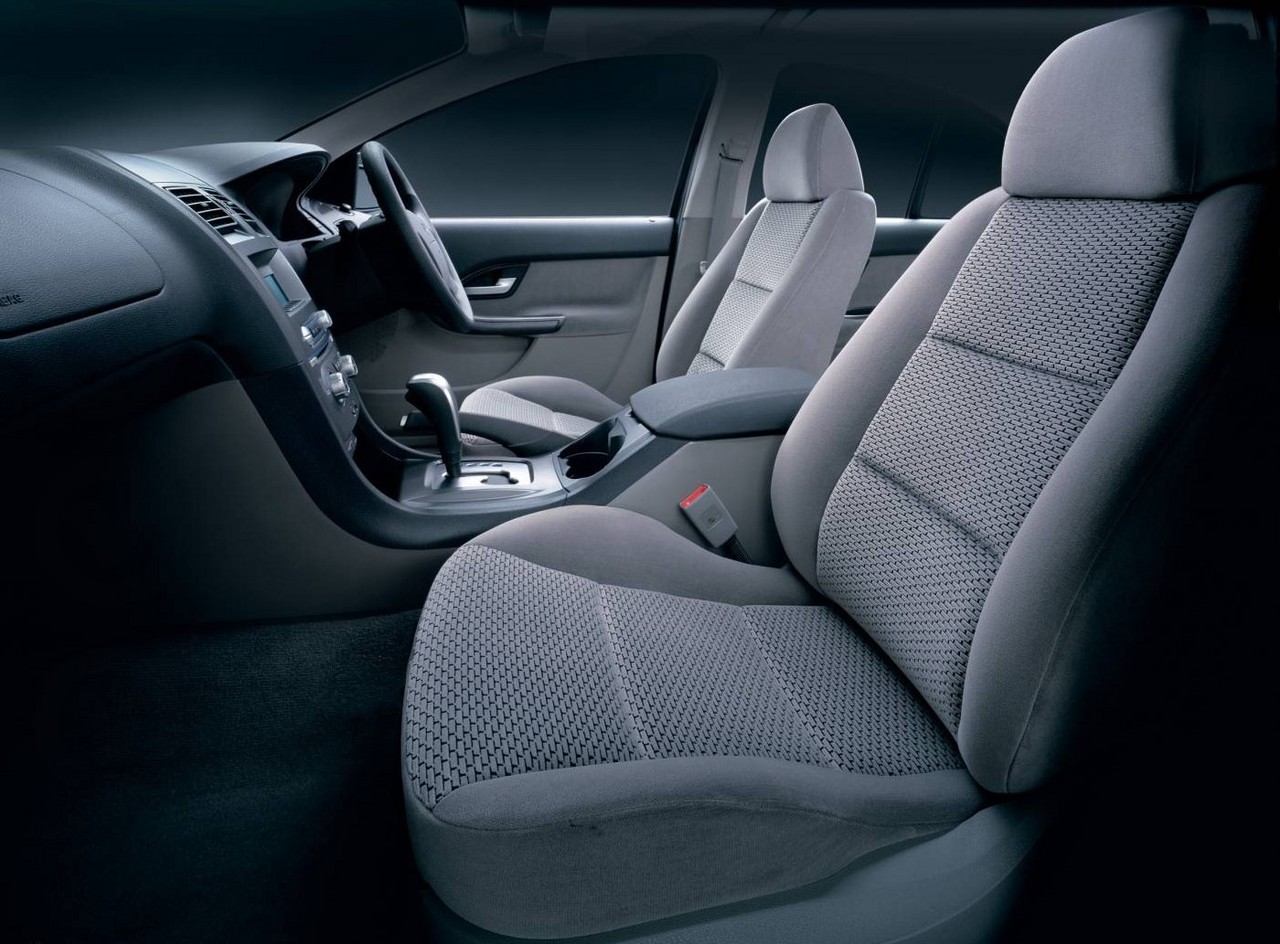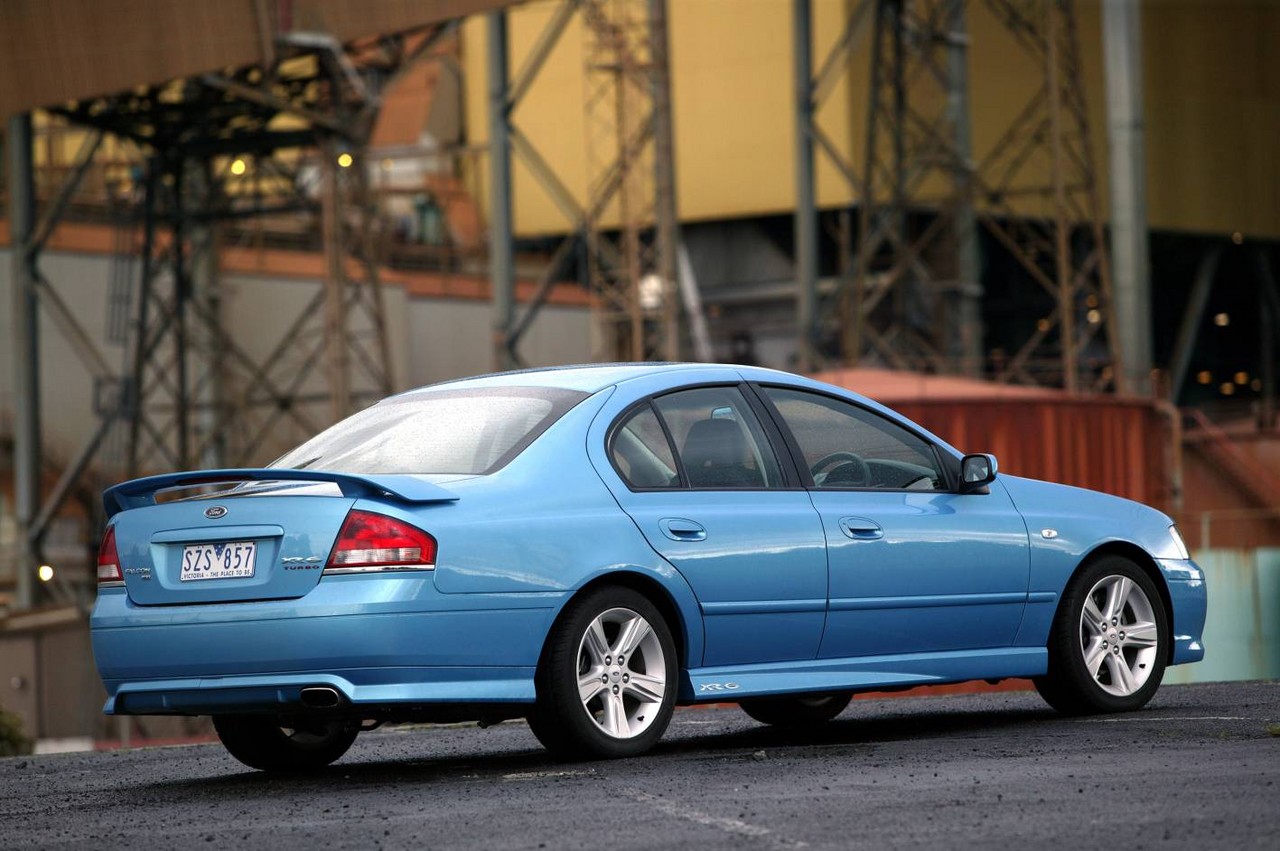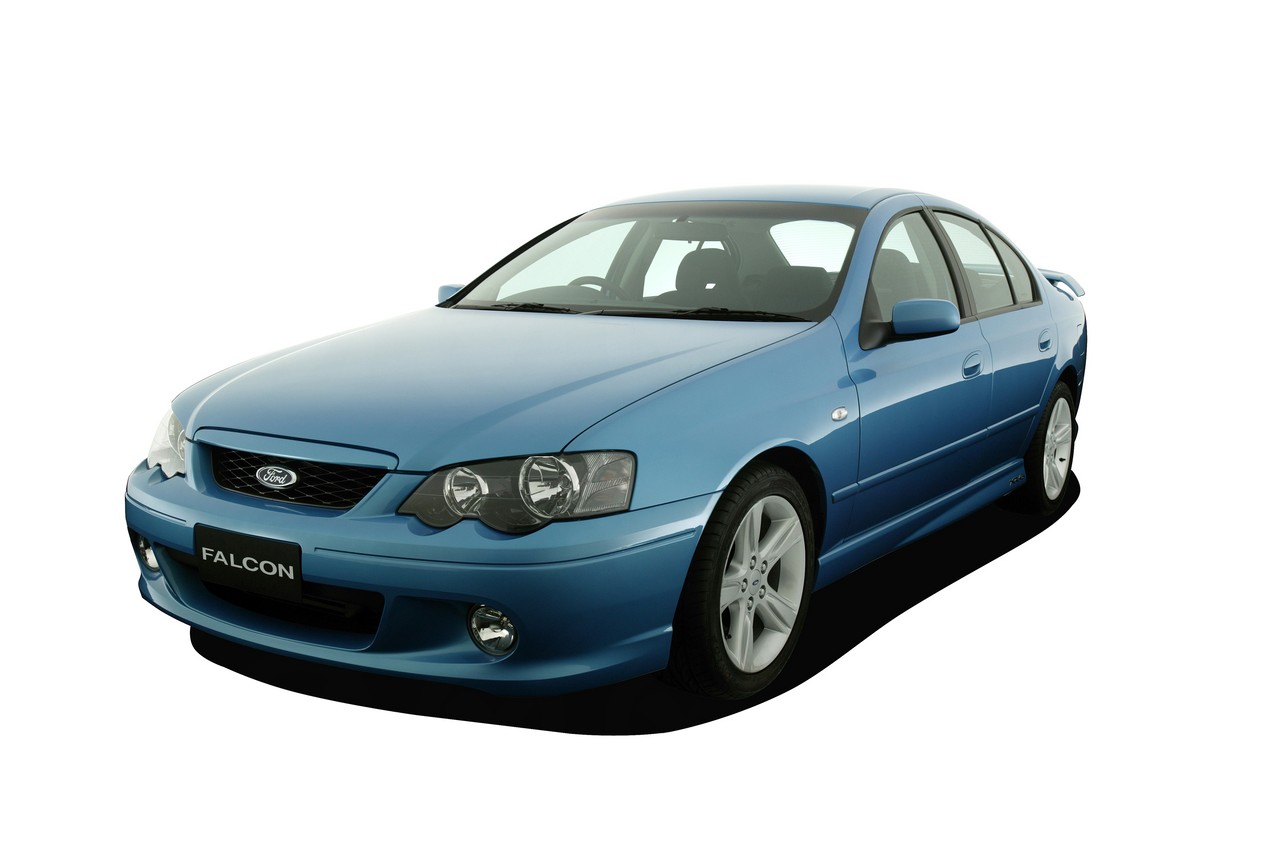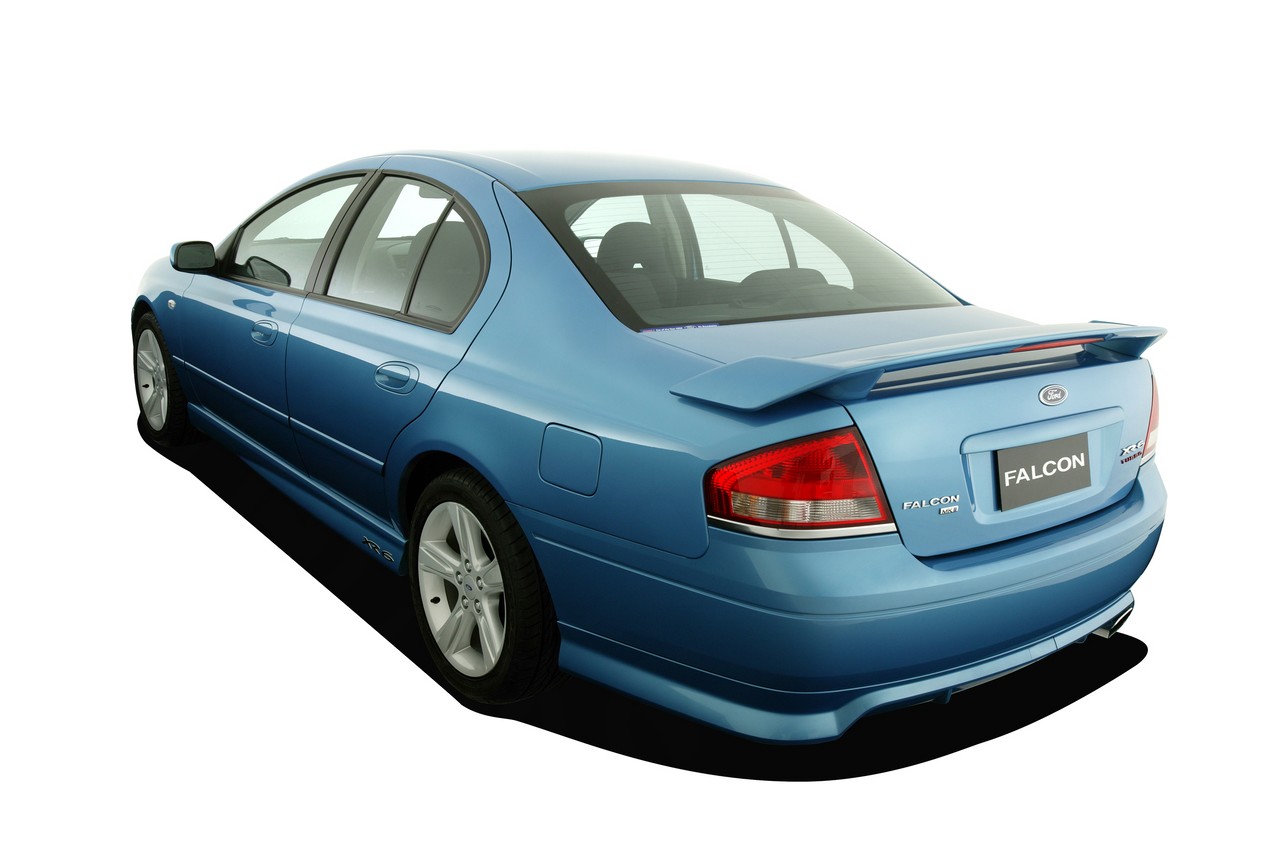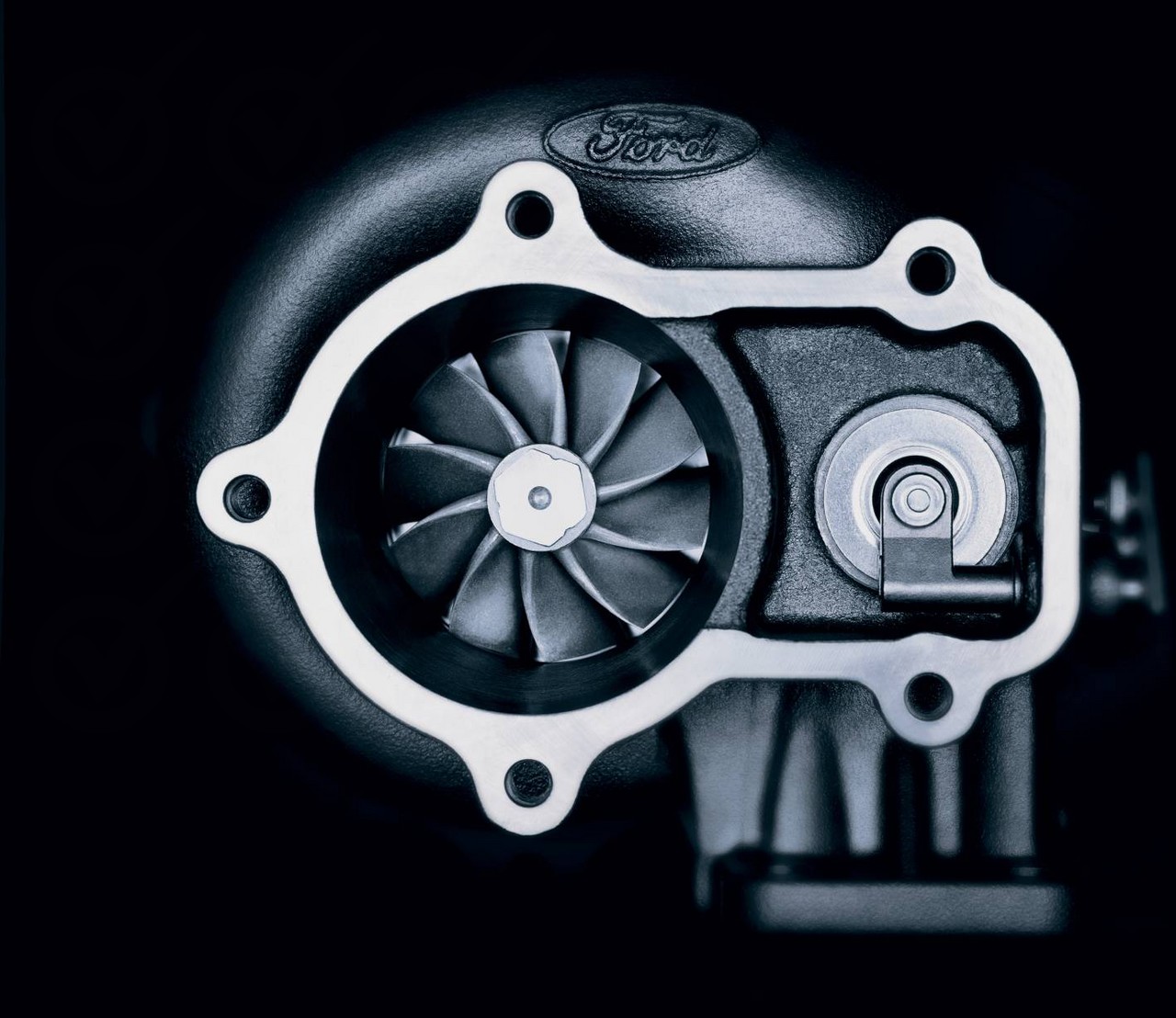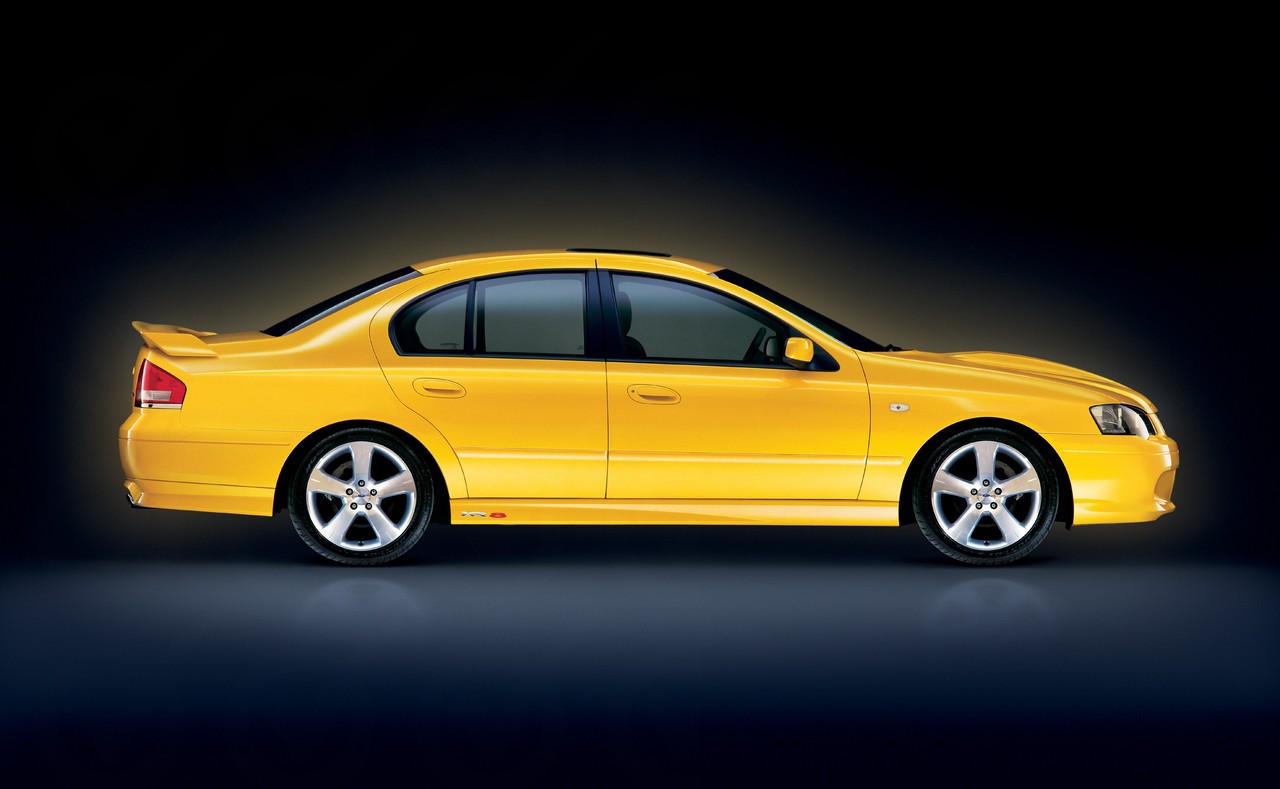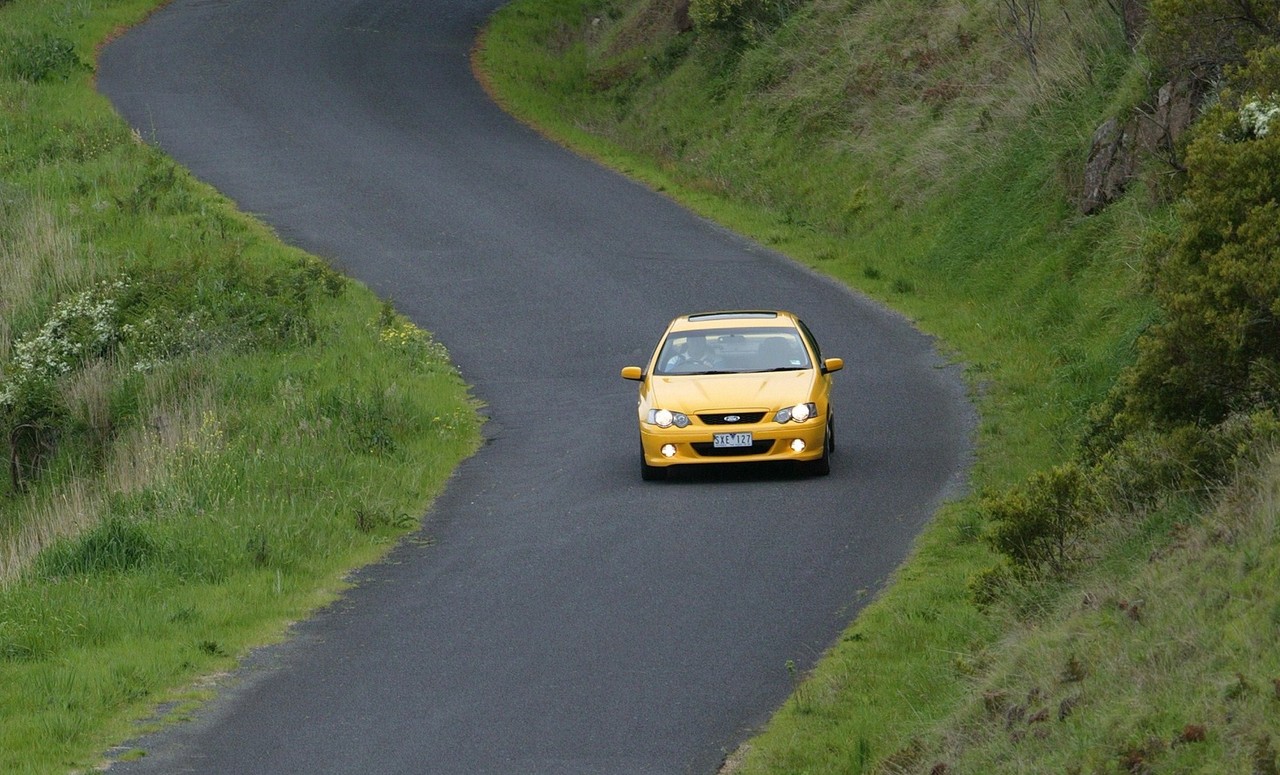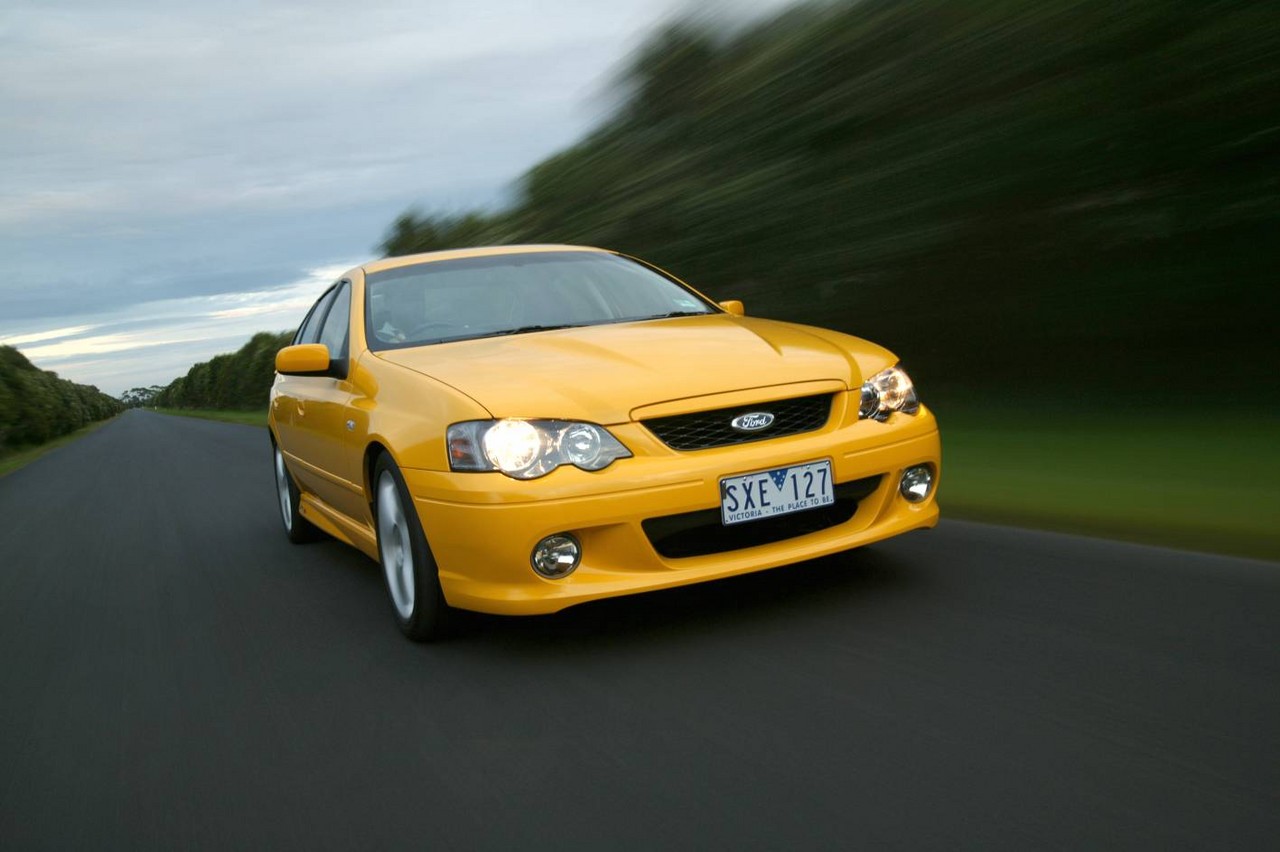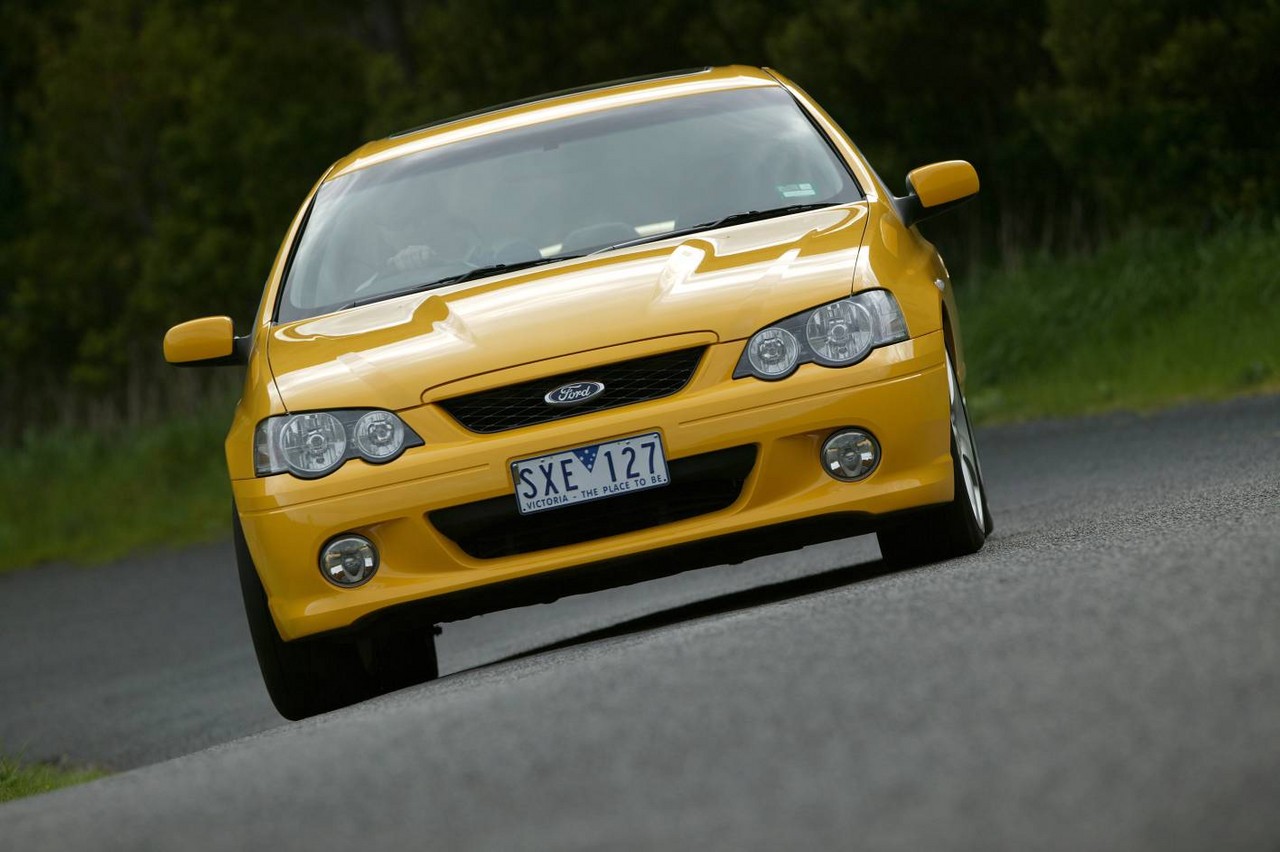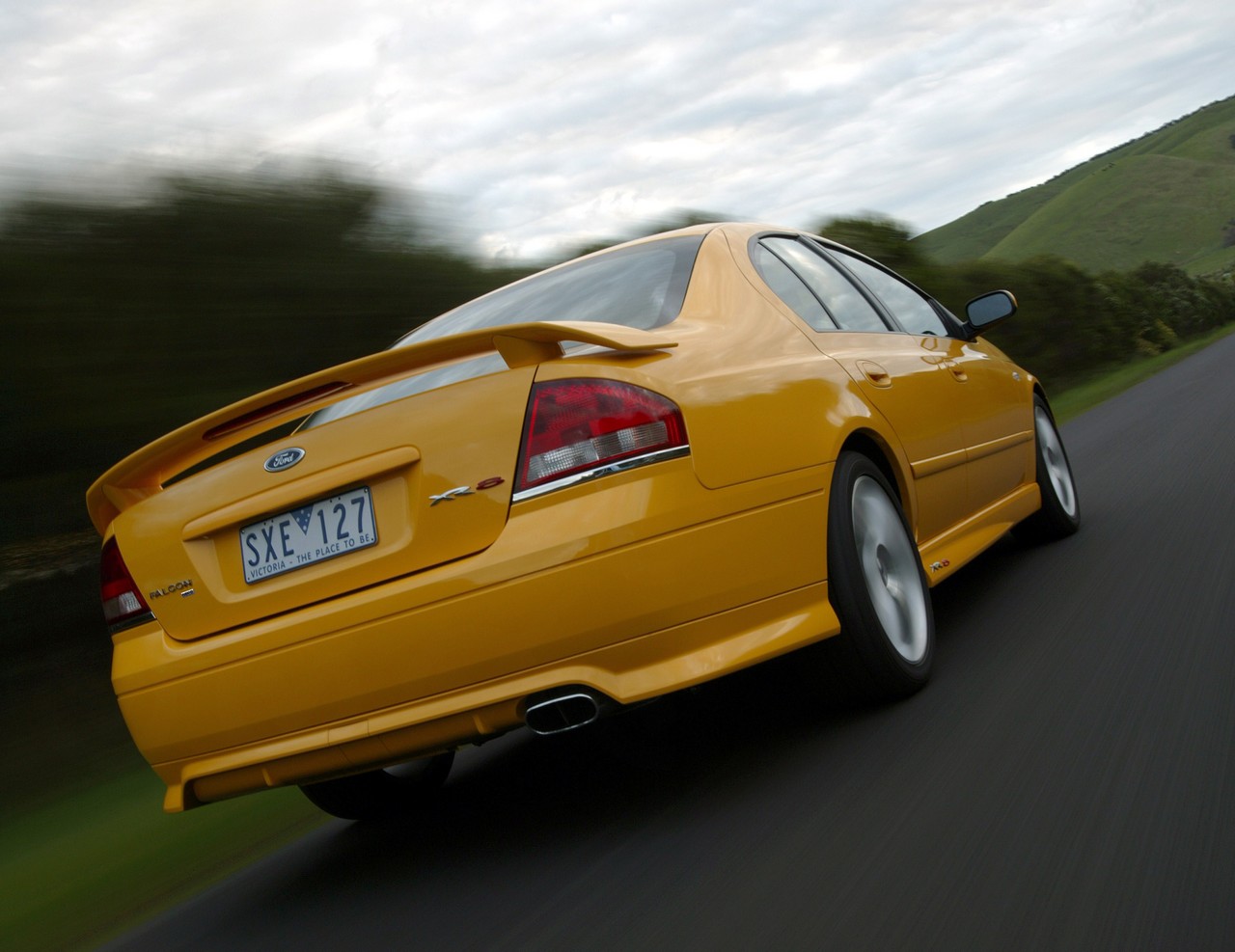
- Responsive 4.0-litre six-cylinder engine
- Powerful engines for XR6 Turbo and XR8
- Accomplished ride/handling balance, while XR variants have impressive dynamics
- Comfortable and spacious interior
- Suspension, driveline and road noise
- Cast-iron 4.0-litre engines are heavy and not particularly fuel-efficient
- Low standard of interior fit and finish
- Overly sensitive steering
- Coolant lines for automatic transmission cooler susceptible to failure
Review: Ford BA.I Falcon (2002-04)
Overview
Released in October 2002, the Ford BA Mark I (BA.I) Falcon was available as a large sedan or wagon. Manufactured in Campbellfield, Victoria, the rear-wheel drive Ford BA Falcon was available with 4.0-litre six cylinder petrol, turbocharged 4.0-litre six cylinder petrol, 4.0-litre six cylinder LPG and 5.4-litre V8 petrol engines. As per the table below, the BA Falcon range initially consisted of XT, Futura, XR6 and XR6 Turbo variants, with the Falcon XR8 following in January 2003.
Engines: Barra 182, Barra 240T, E-Gas, Barra 220 and Boss 260
Of the engines,
- The 4.0-litre Barra 182 inline six-cylinder petrol engine had a cast iron block, a cast aluminium cylinder head, double overhead camshafts (DOHC, simplex chain-driven), dual infinitely variable camshaft adjustment (within a 60 degree range), four valves per cylinder, Duratec-style finger followers, a dual resonance inlet manifold, coil-on-plug ignition and a compression ratio of 9.7:1. Compared to its Intech predecessor, changes for the Barra six cylinder engine included a new cylinder head (50 per cent stiffer than its predecessor), forged camshafts (previously cast iron), new combustion chambers, port design, a single chain drive for the camshafts, electronic ‘drive by wire’ throttle control, internal exhaust gas recirculation, a crank-mounted oil pump, new knock sensors (for improved performance on premium unleaded fuel) and an upgraded Powertrain Control Module (PCM). The rev limit was also raised to 6000 rpm (previously 5700 rpm);
- The 4.0-litre Barra 240T engine added a Garrett GT3582R turbocharger which had engine oil-lubricated and water-cooled bearings, an air-to-air intercooler and an electronic single bypass wastegate. The turbocharger was mounted off a cast stainless steel exhaust manifold and provided maximum boost pressure of 6 psi (0.413 bar). Furthermore, the Barra 240T engine had a compression ratio of 8.7:1 and a 6000 rpm redline, while a knock sensor enabled the engine to run on regular unleaded fuel, though premium unleaded was recommended for optimum performance. Compared to the Barra 182 engine , the Barra 240T engine had new pistons with a ‘dished bowl’ shape and a fully floating gudgeon pin, more temperature tolerant exhaust valves, increased fuel pressure (4 bar, compared to 2.4 bar) and heavier duty lubricating oil. Heat shields were also installed to protect components such as the steering column assembly and the under floor area above the three-inch dump pipe and the catalysts;
- The 4.0-litre Barra E-Gas dedicated LPG engine had a Vialle closed-loop single-point carburetion system, hardened valves and valve seats, and a compression ratio of 10.7:1. For sedans, the tank fitted under the rear of the vehicle and had a capacity of 93 litres (116 litres for wagons);
- Manufactured at Ford’s Windows plant in Canada, the 5.4-litre Barra 220 V8 engine had a cast iron block, a cast aluminium cylinder head, sintered connecting rods, a single overhead camshaft (SOHC), variable intake camshaft timing (over 60 degrees relative to the crankshaft), three valves per cylinder (two intake, one exhaust), roller finger followers, coil on plug ignition and a compression ratio of 9.7:1. Compared to its 4.9-litre Windsor V8 predecessor, changes included a stiffer block, reshaped pistons (with longer side skirts), magnesium cam covers, electronic throttle control, internal exhaust gas recirculation and failsafe-cooling protection (previously limited to inline six cylinder engines); and,
- Assembled by hand in Campbellfield, the 5.4-litre Boss 260 V8 engine had double overhead camshafts, four valves per cylinder and a compression ratio of 9.52:1, but omitted the variable cam timing of the Barra 220. The Boss 260 engine combined the long stroke 5.4-litre block with high-lift camshaft profiles, specific inlet camshaft to match the high-rise inlet manifold and exhaust header system, forged steel crankshaft, Boss fuel rail with upgraded injectors, 75 mm throttle body, low-restriction air-intake with a conical filter, 1 7/8inch stainless steel exhaust headers, and an FPV oil pan and oil pick-up.
Transmissions
Of the transmissions,
- The naturally aspirated six-cylinder engines were available with four-speed BTR M93LE automatic or five-speed BTR T5 manual transmissions;
- For the XR6 Turbo, the turbocharged six-cylinder engine was available with four-speed BTR M95LE automatic or five-speed BTR T5Z manual transmissions; and,
- The 5.4-litre V8 engine was available with four-speed BTR M97LE automatic or five-speed Tremec TR3650 manual transmissions.
For the Ford BA range, changes for the automatic transmissions included a higher contact ratio gear set, a new design alloy plate (finned) transmission oil cooler and upgrades for the valve body, pump assemblies and torque converters. For the XR6 Turbo, its M95LE automatic transmission had an additional clutch pack, stronger gear set, reinforced torque converter and a Kevlar front band. Furthermore, all automatic transmissions had an adaptive shifting program, while all floor-shift automatic transmissions had a ‘Sequential Sports Shift’ function.
Development and dimensions
Compared to the AU Falcon , the BA Falcon’s chassis achieved an 88 per cent increase in torsional rigidity. Other developments for the BA range included:
- For sedans, independent rear suspension (detailed below) and a new two-piece drive shaft with a constant velocity (CV) joint at the differential;
- A new alloy cross member under the transmission with alloy mountings;
- A stainless steel exhaust system was fitted as standard and, for sedans, exhaust capacity increased to 36 litres (previously 17 litres);
- A stiffer steering column, quicker steering ratio (2.8 turns lock-to-lock) and revised steering gear;
- New hydraulic engine mounts; and,
- New insulating foam between the body and carpets.
Relative to the Ford AU Falcon , the BA Falcon sedan was 9 mm longer (at 4916 mm), 6 mm narrower (1864 mm), 37 mm lower (1444 mm) and had a 36 mm longer wheelbase (2829 mm); its drag coefficient also decreased to 0.292 Cd (previously 0298 Cd). As a result of the stiffer chassis and independent rear suspension, kerb mass increased by 130 kg for the BA Falcon XT sedan relative to the AU Falcon Forte.
Compared to the sedan, the BA Falcon wagon was 137 mm longer (at 5053 mm), 86 mm taller (1530 mm) and had a 92 mm longer wheelbase (2921 mm).
Suspension
The Ford BA Falcon had double wishbone front suspension (with revised mounting points and top mount bushing).
Suspension
The Ford BA Falcon had double wishbone front suspension and, for sedans, independent rear suspension (IRS) which had three control arms:
- A forged upper control arm;
- A stamped front lower control arm; and,
- A stamped rear lower control arm.
Each control arm had a cross axis ball joint on the wheel assembly end and was attached to the subframe and knuckle. Furthermore, the ‘Control Blade’ was a stamped trailing arm which provided lateral support and acted as a vertical pivot point.
BA Falcon wagons, however, continued to have ‘Hotchkiss’ rear suspension which consisted of a live rear axle that was suspended by leaf springs.
| Body | Variant | Engine | Trans. | Peak power | Peak torque |
|---|---|---|---|---|---|
| Sedan | XT | 4.0-litre Barra 182 petrol I6 | 4sp auto, 5sp man. |
182 kW at 5000 rpm | 380 Nm at 3250 rpm |
| 4.0-litre Barra E-Gas LPG I6 | 4sp auto | 156 kW at 4750 rpm | 372 Nm at 3000 rpm | ||
| 5.4-litre Barra 220 petrol V8 | 4sp auto, 5sp man. |
220 kW at 4750 rpm | 470 Nm at 3250-4000 rpm | ||
| SR | 4.0-litre Barra 182 petrol I6 | 4sp auto, 5sp man. |
182 kW at 5000 rpm | 380 Nm at 3250 rpm | |
| 5.4-litre Barra 220 petrol V8 | 4sp auto, 5sp man. |
220 kW at 4750 rpm | 470 Nm at 3250-4000 rpm | ||
| Futura | 4.0-litre Barra 182 petrol I6 | 4sp auto | 182 kW at 5000 rpm | 380 Nm at 3250 rpm | |
| 4.0-litre Barra E-Gas LPG I6 | 4sp auto | 156 kW at 4750 rpm | 372 Nm at 3000 rpm | ||
| XR6 | 4.0-litre Barra 182 petrol I6 | 4sp auto, 5sp man. |
182 kW at 5000 rpm | 380 Nm at 3250 rpm | |
| XR6 Turbo | 4.0-litre Barra 240T turbo petrol I6 | 4sp auto, 5sp man. |
240 kW at 5250 rpm | 450 Nm at 2000-4500 rpm | |
| XR8 | 5.4-litre Boss 260 petrol V8 | 4sp auto, 5sp man. |
260 kW at 5250 rpm | 500 Nm at 4250 rpm | |
| Wagon | XT, | 4.0-litre Barra 182 petrol I6 | 4sp auto | 182 kW at 5000 rpm | 380 Nm at 3250 rpm |
| Futura | 4.0-litre Barra E-Gas LPG I6 | 4sp auto | 156 kW at 4750 rpm | 372 Nm at 3000 rpm |
Safety equipment
Standard safety equipment for the Ford BA Falcon included dual front airbags (two-stage), ABS, electronic brake force distribution and front seatbelts with pretensioners and load limiters; the XR6 Turbo and XR8 were also fitted with traction control. Front side airbags were not fitted as standard but were available as an extra-cost option.
Brakes
The standard braking package for the BA Falcon consisted of 298 mm by 28 mm vented front brake discs with twin-piston aluminium callipers and 303 mm by 16 mm solid rear discs with single piston callipers. The optional premium braking package had 325 mm by 32 mm grooved front brake discs and 303 mm by 16 mm grooved rear discs.
ANCAP crash testing
In ANCAP crash testing , a 4.0-litre BA.I Falcon XT achieved a four-star occupant safety rating with a score of 27.27 out of 37. In the offset crash test, there was a marginal risk of serious chest injury for both front occupants and lower leg injury for the driver. In the side impact test, there was a marginal risk of serious chest injury for the driver.
Features: Falcon XT and Futura
Standard features for the Ford BA Falcon XT included 16-inch steel wheels with 215/60 R16 tyres, a 100 watt sound system with four speakers, a CD player, MP3-compatibility and a 3.5 mm auxiliary input, air conditioning, ‘Raschel’ seat fabric, a four-way power adjustable driver’s seat, steering wheel audio controls, a 60/40 split and folding rear seat, remote central locking, power mirrors and front windows, a tilt and reach adjustable steering wheel, height adjustable driver’s seat, trip computer and immobiliser. Inside, the BA Falcon featured a satin-finish centre console and ‘Interior Command Centre’ (ICC) with a large LCD.
The Falcon Futura was further equipped with 16-inch alloy wheels, front passenger adjustable lumbar support, a two-tone ‘Stone’ trim interior, cruise control, power rear windows and a centre armrest with cupholders. The Futura was also fitted with body-coloured side protection mouldings and door mirrors.
Features: Falcon XR6, XR6 Turbo and XR8
Compared to the Falcon XT, the Falcon XR6 added 17-inch alloy wheels with Dunlop SP3000 235/45 ZR17 tyres and sports suspension, contoured sports seats with darker ‘Warm Charocal’ trim, cruise control, a leather-wrapped steering wheel, adjustable front passenger seat lumbar support and front fog lamps. The XR6 Turbo and XR8 were also equipped with rear power windows and a limited slip differential.
Visually, the XR variants were distinguished by their quad-headlights, bodykit, rear spoiler and body-coloured side protection mouldings and mirrors.
2004 Falcon XT Classic and Falcon SR
In May 2004, the Falcon XT Classic and Falcon SR were released. Compared to the standard XT variant, both added cruise control, ‘Prestige Audio System’ with six-stack CD player and LCD display, rear power windows and unique designer sports seats and door trim. The Classic edition was also fitted with 16-inch five-spoke alloy wheels and DVD player; the SR, however, could be identified by its 17-inch seven-spoke alloy wheels with sports suspension, body kit, rear spoiler and leather-wrapped sports steering wheel.
Related links
- Technical Specifications: Ford BA Falcon I6 (October 2002)
- Technical Specifications: Ford BA Falcon V8 (October 2002)
- Specifications and features: Ford BA.I Falcon (2003)
Review: Ford BA.II Falcon (2004-05)
Overview
Released in October 2004, the Ford BA Mark II (BA.II) Falcon introduced improved equipment levels and minor cosmetic changes. The range itself was substantially unchanged, though the Tremec T56 six-speed manual transmission was available in the XR6 Turbo and XR8 variants.
Previously used in the Ford Mustang Cobra R , the Tremec T56 manual transmission had double synchros in its forward gears and a single synchro in reverse. With the T56 transmission, the final drive ratios for the XR6 Turbo and XR8 were 3.73:1 (previously 3.46:1) and 3.46:1 (previously 3.23:1).
The suspension was also revised for the BA.II XR8 with firmer 80 N/mm front and rear 41 N/mm springs fitted (previously 70 N/mm front and 38 N/mm rear) for sharper steering response.
| Body | Variant | Engine | Trans. | Peak power | Peak torque |
|---|---|---|---|---|---|
| Sedan | XT | 4.0-litre Barra 182 petrol I6 | 4sp auto, 5sp man. |
182 kW at 5000 rpm | 380 Nm at 3250 rpm |
| 4.0-litre Barra E-Gas LPG I6 | 4sp auto | 156 kW at 4750 rpm | 372 Nm at 3000 rpm | ||
| 5.4-litre Barra 220 petrol V8 | 4sp auto, 5sp man. |
220 kW at 4750 rpm | 470 Nm at 3250-4000 rpm | ||
| SR | 4.0-litre Barra 182 petrol I6 | 4sp auto, 5sp man. |
182 kW at 5000 rpm | 380 Nm at 3250 rpm | |
| 5.4-litre Barra 220 petrol V8 | 4sp auto, 5sp man. |
220 kW at 4750 rpm | 470 Nm at 3250-4000 rpm | ||
| Futura | 4.0-litre Barra 182 petrol I6 | 4sp auto | 182 kW at 5000 rpm | 380 Nm at 3250 rpm | |
| 4.0-litre Barra E-Gas LPG I6 | 4sp auto | 156 kW at 4750 rpm | 372 Nm at 3000 rpm | ||
| XR6 | 4.0-litre Barra 182 petrol I6 | 4sp auto, 5sp man. |
182 kW at 5000 rpm | 380 Nm at 3250 rpm | |
| XR6 Turbo | 4.0-litre Barra 240T turbo petrol I6 | 4sp auto, 6sp man. |
240 kW at 5250 rpm | 450 Nm at 2000-4500 rpm | |
| XR8 | 5.4-litre Boss 260 petrol V8 | 4sp auto, 6sp man. |
260 kW at 5250 rpm | 500 Nm at 4250 rpm | |
| Wagon | XT, Futura |
4.0-litre Barra 182 petrol I6 | 4sp auto | 182 kW at 5000 rpm | 380 Nm at 3250 rpm |
| 4.0-litre Barra E-Gas LPG I6 | 4sp auto | 156 kW at 4750 rpm | 372 Nm at 3000 rpm |
Safety equipment
Compared to its BA.I predecessor, safety equipment for the BA.II Falcon was enhanced with the Futura fitted with front side airbags while the XR6 was fitted with traction control.
Features
Standard features for the BA.II Falcon were extended to include cruise control and automatic headlights and the Futura was fitted with power adjustable pedals.
The XR6 was fitted with new 17-inch alloy wheels, rear power windows, a second row centre armrest and alloy pedal covers. The XR8 was fitted with 18-inch alloy wheels and an upgraded six speaker sound system with a six-disc CD player. The XR8’s suspension also had firmer spring rates for better steering response and flatter handling.
2005 Falcon SR
In March 2005, the limited-run Falcon SR was released. Based on the XT, the Falcon SR had 17-inch alloy seven-spoke wheels with sports suspension, an upgraded six speaker sound system with six-disc CD player, rear power windows, a leather-wrapped sports steering wheel, a sports body kit and rear spoiler.
2005 Falcon XR8 Devil R and Enforcer editions
In April 2005, limited-run ‘Devil R’ and ‘Enforcer’ editions of the XR8 were offered. Both featured 18-inch shadow chrome alloy wheels, a premium braking package, sports leather seats, a leather-wrapped steering wheel, embroidered carpet mats and an engine bay signature plate. The Devil R was solely available with a ‘Shockwave’ blue paint finish, while the Enforcer was offered in ‘Envy’ green.
Related links

